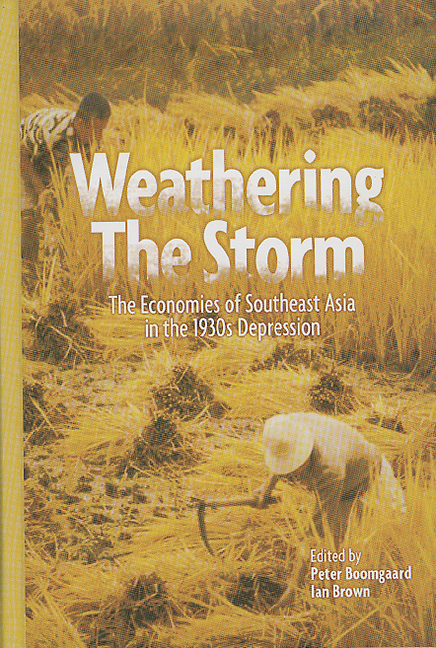Book contents
- Frontmatter
- Contents
- List of Tables
- List of Figures
- Acknowledgements
- List of Contributors
- 1 The Economies of Southeast Asia in the 1930s Depression: An Introduction
- PART I MATERIAL CONDITIONS
- PART II AGRICULTURAL STRATEGIES
- 6 Structural Origins of the Economic Depression in Indonesia During the 1930s
- 7 Entrepreneurial Strategies in Indigenous Export Agriculture in the Outer Islands of Colonial Indonesia, 1925-38
- 8 The Economy of Besuki in the 1930s Depression
- 9 The Rice Economy of Thailand in the 1930s Depression
- 10 Rice and the Colonial Lobby: The Economic Crisis in French Indo-China in the 1920s and 1930s
- PART III TRADING COMMUNITIES
- PART IV THE STATE'S RESPONSE
- Index
8 - The Economy of Besuki in the 1930s Depression
from PART II - AGRICULTURAL STRATEGIES
Published online by Cambridge University Press: 21 October 2015
- Frontmatter
- Contents
- List of Tables
- List of Figures
- Acknowledgements
- List of Contributors
- 1 The Economies of Southeast Asia in the 1930s Depression: An Introduction
- PART I MATERIAL CONDITIONS
- PART II AGRICULTURAL STRATEGIES
- 6 Structural Origins of the Economic Depression in Indonesia During the 1930s
- 7 Entrepreneurial Strategies in Indigenous Export Agriculture in the Outer Islands of Colonial Indonesia, 1925-38
- 8 The Economy of Besuki in the 1930s Depression
- 9 The Rice Economy of Thailand in the 1930s Depression
- 10 Rice and the Colonial Lobby: The Economic Crisis in French Indo-China in the 1920s and 1930s
- PART III TRADING COMMUNITIES
- PART IV THE STATE'S RESPONSE
- Index
Summary
INTRODUCTION
In the study of economic history, the 1930s depression, which is often relegated from the discussion of political history, is an important subject for research. Its importance is due to its wide consequences for the economic activity and social conditions of various communities. The depression also greatly influenced the economic and social development of colonial Indonesian society. It marked the end of the liberal system which had been in place since 1870. The colonial government abandoned non-intervention in the economy and began to put various regulations and restrictions into effect.
The depression, which began in 1929 and lasted to about 1939, was worldwide in scope, and has been described as the most severe economic decline in the first half of the twentieth century. It adversely affected colonial Indonesia, which had been closely integrated into the international market through the development of a plantation economy. In the context of the general expansion of the colonial economy which began in the second half of the nineteenth century, the 1930s depression was a major turning point in the economic development of colonial Indonesia.
It has been said that colonial Indonesia felt the worst and longest impact of the world depression, that the 1930s depression was an economic catastrophe for colonial Indonesia. But this dark view rests on a number of misconceptions of the 1930s crisis. One reason for these misconceptions is the lack of comprehensive studies which focus on Indonesian economic history in general and on the 1930s depression in particular. Although the 1930s depression is mentioned in some macro-level studies, the treatment is rarely convincing. In the standard book of Indonesian national history, for example, there is merely a brief statement that the depression imposed economic pressures on the Indonesian people and created a wider gap between them and the Europeans.
- Type
- Chapter
- Information
- Weathering the StormThe Economies of Southeast Asia in the 1930s Depression, pp. 171 - 188Publisher: ISEAS–Yusof Ishak InstitutePrint publication year: 2001

